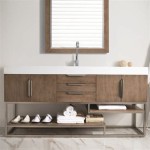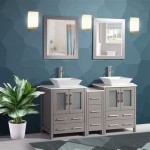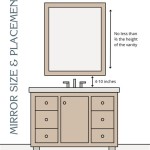Antique Bathroom Vanities and Sinks: A Detailed Exploration
Antique bathroom vanities and sinks represent a distinct category within the realm of interior design, offering a unique blend of historical charm and practical functionality. These pieces are not merely functional fixtures; they are often considered artistic expressions, reflecting the craftsmanship and design aesthetics of past eras. The appreciation for antique bathroom vanities and sinks stems from their inherent value, rarity, and the character they bring to a bathroom space.
The term "antique," in the context of furniture and fixtures, typically refers to items that are at least 100 years old. However, pieces that are somewhat newer but possess a strong vintage appeal, unique design elements, or notable historical significance are often included under the umbrella of antique or vintage bathroom vanities and sinks. These pieces stand in contrast to modern, mass-produced bathroom fixtures, offering a connection to history and a distinctive aesthetic.
Identifying genuine antique bathroom vanities and sinks requires a keen eye for detail, an understanding of historical design periods, and familiarity with common materials and manufacturing techniques used in the past. Evaluating the authenticity and condition of these pieces often involves consulting with experts or delving into historical resources to verify their provenance and value.
Differentiating Features of Antique Bathroom Vanities and Sinks
Antique bathroom vanities and sinks are characterized by a range of features that distinguish them from their modern counterparts. These features encompass the materials used, the construction techniques employed, the design styles prevalent during specific historical periods, and the unique hardware and decorative elements incorporated into the pieces.
One of the primary differentiating factors is the materials used. Antique vanities were often crafted from solid hardwoods like mahogany, oak, walnut, and cherry. These woods were selected for their durability, workability, and aesthetic qualities. In contrast, modern vanities often utilize engineered wood products or lightweight materials. Similarly, antique sinks were frequently made from cast iron, porcelain, or marble, materials known for their robustness and classic appeal. Modern sinks may incorporate materials like acrylic, glass, or composite materials.
Construction techniques also vary significantly. Antique vanities were typically assembled using traditional woodworking methods such as dovetail joints, mortise-and-tenon joints, and hand-carved details. These methods resulted in sturdy and long-lasting pieces. Modern vanities often rely on screws, staples, or adhesives for assembly, which may not provide the same level of structural integrity. Likewise, the manufacturing processes for antique sinks were often labor-intensive, involving casting, firing, and hand-finishing, resulting in unique variations and imperfections that contribute to their character.
The design styles prevalent during different historical periods also contribute to the distinctiveness of antique bathroom vanities and sinks. Styles range from the ornate Victorian era with its elaborate carvings and embellishments to the streamlined Art Deco period with its geometric shapes and luxurious materials. Each period reflects the prevailing aesthetic sensibilities and technological capabilities of its time. Understanding these design styles is crucial for identifying and appreciating the historical significance of antique bathroom fixtures.
Hardware and decorative elements further enhance the unique character of antique bathroom vanities and sinks. Original hardware, such as knobs, pulls, hinges, and faucets, can provide valuable clues about the age and origin of a piece. These elements often feature intricate designs, distinctive patinas, and high-quality craftsmanship. Decorative elements, such as hand-painted details, inlaid patterns, or carved motifs, add to the visual appeal and historical authenticity of the fixtures.
Preserving and Restoring Antique Bathroom Vanities and Sinks
Preserving and restoring antique bathroom vanities and sinks is a delicate process that requires careful consideration of the piece's historical integrity and structural condition. The goal is to maintain the original character and value of the fixture while ensuring its functionality and longevity. Restoration efforts typically involve cleaning, repairing, refinishing, and, in some cases, replacing damaged or missing components.
Cleaning is a crucial first step in the restoration process. Gentle cleaning methods should be employed to remove dirt, grime, and surface stains without damaging the original finish or materials. Specialized cleaning solutions designed for antique furniture and fixtures are often recommended. A soft cloth or brush should be used to avoid scratching or abrading the surface. Harsh chemicals or abrasive cleaners should be avoided, as they can damage the finish and detract from the piece's value.
Repairing structural damage, such as loose joints, cracks, or broken components, is another important aspect of restoration. Traditional woodworking techniques should be used to repair damaged areas, ensuring that the repairs are structurally sound and visually consistent with the original construction. Replacing missing or damaged hardware with appropriate replacements is essential for maintaining the authenticity of the piece. Sourcing antique or reproduction hardware that matches the original style and finish can be a challenging but rewarding task.
Refinishing antique bathroom vanities requires careful consideration of the existing finish and the desired outcome. In some cases, preserving the original finish, even if it shows signs of wear and tear, is preferable to stripping and refinishing the piece. Original finishes often retain historical value and contribute to the piece's character. However, if the finish is severely damaged or deteriorated, refinishing may be necessary. The choice of refinishing products and techniques should be made with careful consideration of the piece's age, materials, and historical context. Traditional finishing methods, such as shellac or varnish, are often preferred for antique furniture.
Restoring antique sinks may involve repairing cracks, chips, or stains in the porcelain or cast iron. Specialized repair kits and techniques are available for repairing these types of damage. Re-enameling a cast iron sink can restore its original luster and protect it from further corrosion. However, re-enameling can be a costly and complex process, so it is important to carefully evaluate the condition of the sink and the potential benefits of restoration before proceeding.
Proper preservation also involves protecting the antique bathroom vanity or sink from future damage. This may include applying protective coatings, controlling humidity and temperature levels in the bathroom, and avoiding the use of harsh chemicals or abrasive cleaners. Regular maintenance, such as dusting and cleaning with gentle solutions, can help to preserve the beauty and integrity of the piece for years to come.
Integrating Antique Bathroom Vanities and Sinks into Modern Bathrooms
Integrating antique bathroom vanities and sinks into modern bathrooms requires a thoughtful approach to design and functionality. The goal is to create a cohesive and harmonious space that combines the charm and character of antique fixtures with the convenience and style of modern amenities. This often involves balancing the aesthetic appeal of the antique pieces with the practical requirements of a contemporary bathroom.
One of the primary considerations is the size and scale of the antique vanity or sink. Antique fixtures may not conform to standard modern sizes, so careful measurements are essential. Adapting the plumbing and surrounding cabinetry to accommodate the antique piece may be necessary. In some cases, custom cabinetry or modifications to existing fixtures may be required to ensure a proper fit and seamless integration.
Another important consideration is the style and finish of the surrounding bathroom elements. Coordinating the color palette, materials, and design details of the walls, flooring, lighting, and accessories can help to create a cohesive and visually appealing space. Mixing and matching different styles can be effective, but it requires a careful eye and a clear understanding of design principles. For example, pairing an ornate Victorian vanity with sleek, modern fixtures can create a striking contrast, but it is important to ensure that the different elements complement each other in terms of color, scale, and overall aesthetic.
Incorporating modern amenities into an antique bathroom setup may require some creative solutions. For example, concealing modern plumbing behind antique-style faucets and fixtures can help to maintain the historical aesthetic while providing the convenience of modern technology. Adding modern lighting fixtures that complement the style of the antique vanity can enhance the functionality of the space without detracting from its historical character.
The functionality of the antique vanity or sink should also be considered. Ensuring that the fixture meets the needs of the user is essential. Adding storage solutions, such as drawers or shelves, can help to maximize the utility of the vanity. Adapting the sink to accommodate modern plumbing fixtures and drainage systems may be necessary. It is also important to consider the ergonomics of the fixture and ensure that it is comfortable to use.
When integrating antique bathroom vanities and sinks into modern bathrooms, it is important to strike a balance between historical preservation and contemporary functionality. By carefully considering the size, scale, style, and functionality of the antique piece, it is possible to create a beautiful and practical bathroom space that celebrates the charm and character of the past while meeting the needs of the present.

33 Inch Traditional Antique Style Cherry Wood Benson Bathroom Sink Vanity

Antique Style Bathroom Vanity Barnwood Vienna Woodworks

The Interior Gallery Marseille Antique Bathroom Vanity Set

35 Benton Collection Crossfield Antique Style Black Bathroom Vanity

Antique Bathroom Vanity Dresser Custom Converted To Your Specs Painted Bath Vanities 37 48 Wide Etsy

Benton Collection 33 Unique Classic Benson Bathroom Sink Vanity Matching Mirror Model Hf021w Tk Mir

Adelina 42 Inch Traditional Style Antique White Bathroom Vanity

Home Decorators Collection Winslow 60 In Double Sink Freestanding Antique Cherry Bath Vanity With White Marble Top Assembled Bf 27004 Ac The

Riviera 72

Home Decorators Collection Aberdeen 30 In Single Sink Antique Oak Bath Vanity With Carrara Marble Top Assembled 30ao The







